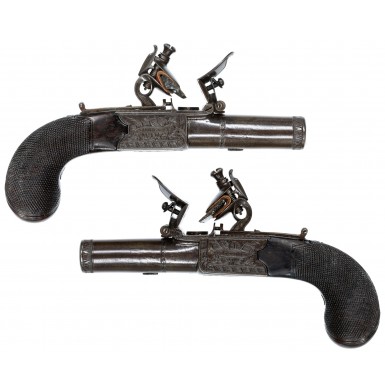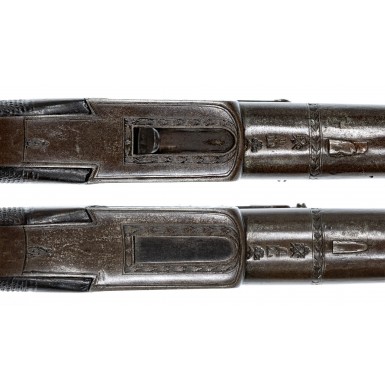A Lovely Pair of English Flintlock Pocket Pistols by James Wilkinson
- Product Code: FHG-C017-SOLD
- Availability: Out Of Stock
-
$2,495.00
This is a lovely pair of Flintlock Pocket Pistols by James Wilkinson of London. The guns are of the classic twist-off, box lock design that was quite popular during the first quarter of the 19th century in England, as well as much of Europe. The twist-off barrel system allowed the pistols to be easily loaded without the use of ramrods. By twisting off the barrel, typically with the help of a barrel wrench, the breeches of the pistols were exposed. A chamber at the rear of the breech was provided to fill with powder and a crescent recess in the face of the chamber provided the seating location for the round ball projectile. Twisting the barrel back on secured the charge in place, as the bores of the guns were very slightly tapered, and the balls used were very slightly oversized when compared to the muzzle diameter. This ensured a tight fit and stable load in the gun. The only step left was to prime the pan and then the pistols could be placed on half cock and were ready to be fired by bringing them to full cock. These guns were designed for discreet concealed carry in a pocket and as such often included pan locking safeties on the top of the frame that secured the frizzen in closed position and folding triggers that only deployed when the cock was placed in the full cock position. The folding triggers that remained concealed and out of the way until needed served the dual purposes of reducing the chance that the gun would snag on the way out of the pocket and provided additional safety against the possibility of the pistol being accidently discharged.
The pistols offered here were made by James Wilkinson of London. Wilkinson had been the foreman of Henry Nock’s manufactory and was married to Nock’s daughter. When Nock died in 1804, Wilkinson took over the business and the following year was appointed Gunmaker-in-Ordinary to King George III. Wilkinson retained Nock’s 17 Ludgate Hill premises and in 1805 became a gunmaker to the East India Company, a position that Nock had held as well from 1771 until his death in 1804. The Wilkinson firm would hold that position with the E.I.C. through 1839. In 1818 the firm became James Wilkinson & Son with the addition of James’ son Henry to the business. During this period the firm became known as “Gunmakers to His Majesty, the Honorable East India Company & the King & Prince Royal of Persia.” The company moved to 12 Ludgate Hill in 1819 where it remained through 1828. It then relocated to 27 Pall Mall where they remained through 1852. Additional locations were added at 4 St. James Square (circa 1839), 56 Mansell Street (circa 1845-1848) and 18 St. Mary’s Axe (circa 1850-1852), which were more than likely retail locations for the company’s guns. James Wilkinson died in 1848 at the advanced age of 90 and his son Henry continued to run the business. Henry received a number of patents during his working life and designed firearms as diverse as an Irish Constabulary Carbine (1835), an underhammer percussion gun (1839) and studied and reported on the rear sight designs that were tried during the development of the Pattern 1853 Enfield Rifle Musket in 1852. Henry also returned to doing contract work for the East Indian Company circa 1848-1853. Henry expanded the company’s business by entering the blade making business and was a sword and edged weapon maker and contractor as well. Henry retired in 1858 and his foreman John Latham took over and expanded the blade making portion of the business even further, eventually incorporating as Wilkinson Sword in 1889. Although Henry died in 1861, the company that bore his family name and that was founded by Henry Nock remains in business to this day as one of the premier razor and cutlery makers in the world.
The pair of Wilkinson pistols offered here remain in FINE overall condition. The guns were either originally blued or browned but now have a wonderfully rich and untouched plum brown patina. The diminutive pistols are only 6 1/8” in overall length with 1 ¾” tapered round barrels that are nominally 38 Bore (.50 caliber) at the muzzles. Like nearly all pistols of this style, the guns are smoothbore. They employ a flint box lock action with folding triggers and sliding pan locking safeties on the tops of the frames. The one-piece checkered walnut grips are of the bag style. The pistols are nicely engraved with floral themes that include lovely thistle patterned boarders around the edges and the muzzle. The obverse frames of the pistols are neatly engraved with combination floral motifs and panoplies of arms with ribboned central panels that is engraved JAs WILKINSON, while the reverse features oval panels that are engraved LONDON. The bottoms of the frames are marked with post-1813 Birmingham proof marks that are separated by a maker’s mark of a raised I over a {Spread-Winged Bird} in a depressed tombstone mark. These marks suggest that the guns may have been made in Birmingham and then simply retailed by James Wilkinson. Neither Blackmore nor Stockel show the maker’s symbol found on these guns and there is no indication that it relates to any of the Wilkinson gun makers. As proofs are 1813 or later and James Wilkinson died in 1818, with the company was subsequently renamed “James Wilkinson & Son”, these guns can be fairly tightly dated to circa 1813-1818. One of the pair is numbered 1 on both the reverse frame and the reverse of the barrel, but the other gun is not so numbered.
As noted, the guns remain in about FINE condition with a lovely plum brown patina that appears to be the result of the original finish oxidizing. The metal is mostly smooth with crisp and clear engraving and markings and shows only some lightly scattered pinpricking and lightly scattered oxidized surface roughness. Both pistols function exactly as they should with the triggers deploying as they should when the guns are placed on full cock and the cocks and triggers functioning correctly. The sliding pan locking safeties work as they should as well. The smooth bores are very good, showing scattered oxidation and some light pitting. One of the barrel wrench lugs shows some minor damage, and some lightly scattered minor handling marks are present on the metal. The one-piece wood grips are in near fine condition with crisp checkering. They both show some minor wear and some flattening to some of the checkering, but they show no abuse and remain solid and free of any breaks, cracks, or repairs.
Overall, this is a lovely pair of English flintlock pocket pistols from the first quarter of the 19th century retailed by a famous London gunmaker whose name is synonymous with quality. The guns are in lovely condition, are 100% complete, correct, and original and were sold by a company that remains in business to this day.
SOLD
Tags: A, Lovely, Pair, of, English, Flintlock, Pocket, Pistols, by, James, Wilkinson













